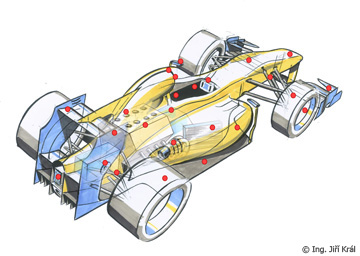The Russian GP according to Brembo An X-ray view of the Formula 1 braking demand on the Sochi track
Alessandra Fedeli/ Brembo | 29.4.16 | Brembo F1 brzdy
Brembo F1 2016
From April 29th to the 1st of May, the Sochi Autodrom will host the 4th round of the 2016 Formula 1 World Championship.
The track, designed by architect Hermann Tilke, runs through the Olympic Village created for the 2014 Sochi Winter Olympics. At 5.848 km long, it is the fourth longest in the Formula 1 World Championship, after Spa-Francorchamps, Baku and Silverstone.Because it is not used very often, the performance of the single-seaters gets better with each session as the asphalt rubberizes. Another unknown is the calendar change because the two previous editions were held in October. For example, in 2015 the asphalt temperature stayed between 25 and 28 degrees Celsius throughout the entire race.According to Brembo technicians, who classified the 21 tracks in the World Championship on a scale of 1 to 10, the Sochi Autodrom falls into the category of the most demanding circuits for brakes. The Sochi track earned a difficulty index of 8, identical Monza's rating.
The demand on the brakes during the GP
The time spent braking, which amounts to 19% of the total race time, is just a bit higher than the numbers on the Shanghai International Circuit. Average deceleration, which is 3.7 g, is identical to Budapest and falls halfway between Shanghai and Melbourne. The energy given off in braking by each car is almost identical to that of Austin and Sakhir: the 135 kWh average for each single-seater is the equivalent of the monthly energy demand for a resident of Uzbekistan. From the lights to the checkered flag, each driver takes on no less than 630 braking sections, applying a total load of 71 tons on the pedal, in other words, the total weight of an M1 Abrams tank and 3 Agusta Westland AW139 helicopters.
The most demanding braking sections
Of the 12 braking sections at the Sochi Autodrom, 3 are classified as demanding for the brakes, 6 are medium difficulty and 3 are light.With a 5.5 g deceleration, turn 2 is the most demanding braking section on the circuit and one of the 10 most difficult in the Championship: the drivers apply a force of 165 kg on the pedal in order to go from 325 to 99 km/h in 1.40 seconds. Turn 13 is also worth a mention: 124 meters of braking with a 5.3 g deceleration to drop from a speed of over 200 km/h.Four of the 6 medium difficulty braking sections are in the central part of the circuit and require a force between 119 and 133 kg on the pedal.The easiest braking section is on turn 16 with just 18 meters of space to drop the speed 16 km.
Brembo Wins
In the 2 editions of the Russian GP that have been held, the cars equipped with Brembo brakes have always taken pole position and have finished first and second in the race. Both GP races were won by Lewis Hamilton in his Mercedes.




